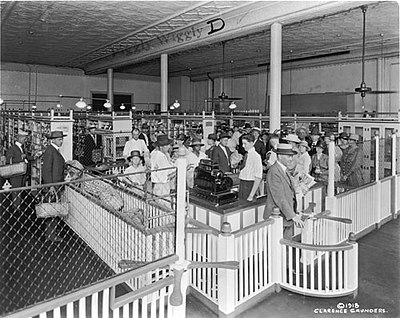Clarence Saunders
 Piggly Wiggly Founder
Piggly Wiggly Founder
1881-1953
by Arian Finley
Clarence Saunders didn’t invent supermarkets. He did, however, make them into what they are today. Born 1881 in Virginia, he moved to Palmyra, Tennessee, working as a clerk in a Clarksville wholesale grocery house at 14. He eventually quit school so that he could work full time. Grocery shopping was much different then. Typically, customers would give a list of items they needed to a clerk, who would gather the items for them. Since the prices were not listed, they were inconsistent, as clerks might charge a few cents lower or higher depending on their relationship with the customer. Additionally, most customers at the time paid on a credit system and would be expected to pay for their groceries at the end of the month. When Saunders left his clerk job, he moved to Memphis, Tennessee, taking up a sales position with another grocery store. These positions gave Saunders experience he needed with the less than ideal conditions of shopping.
Saunders suspected that current grocers were failing on account of credit losses and high labor costs, since chains would have to hire enough clerks to shop for multiple people. He soon tested his theory in 1916 in Memphis, Tennessee, when he opened the first Piggly Wiggly, dubbed “King Piggly Wiggly.” With this, Saunders revolutionized the shopping experience. At Piggly Wiggly, customers were expected to pay with cash, after selecting from over one thousand products, with prices clearly labeled. Not only did this make shopping easier, Saunders was able to effectively lower the prices of the products, due to the cut in labor costs. That year, Saunders opened eight more stores in Memphis, and by 1923, he had opened over 1,200 stores across states.

With his new wealth, Saunders began construction on The Pink Palace, a mansion in Memphis colored pink after the Piggly Wiggly store that made him successful. Before long, however, he lost control of his own company after issuing public stock. As a result, Saunders went bankrupt and lost his mansion. In 1930, the Pink Palace became home to the Memphis Museum of Natural History and Industrial Arts, which still stands today and has a replica of the original Piggly Wiggly store.
Even after losing everything, Saunders still continued to dream. He opened a new store called “Clarence Saunders Sole Owner of My Name.” Sole Owners grew quickly, finding its own respectable reputation and having almost a thousand stores by 1928. With this fortune, Saunders purchased a new home, “Woodland,” in addition to a professional football team renamed “Clarence Saunders Sole Owner of My Name Tigers.”
Unfortunately, Sole Owners declared bankruptcy in 1930. Saunders continued to create ideas that would be deemed beyond his own time. In 1937, he constructed a prototype for a store called Keedoozle, an automated store with mechanics that ran much like a vending machine. He opened twelve stores in the U.S., however, the machinery was unreliable, and Keedoozle was forced to close in 1949. Undeterred, Saunders developed “Foodelectric,” another automated store idea, which is similar to today’s self-checkout system. Before it was completed, Clarence Saunders died of heart failure in 1953.
With just over 600 stores still open, Piggly Wiggly is no longer a powerhouse in the shopping industry, with strong competitors such as Walmart and Kroger. Despite this, Piggly Wiggly’s influence hasn’t faded, with these same competitors owing much to Clarence Saunders’ drive and determination to change the industry.


